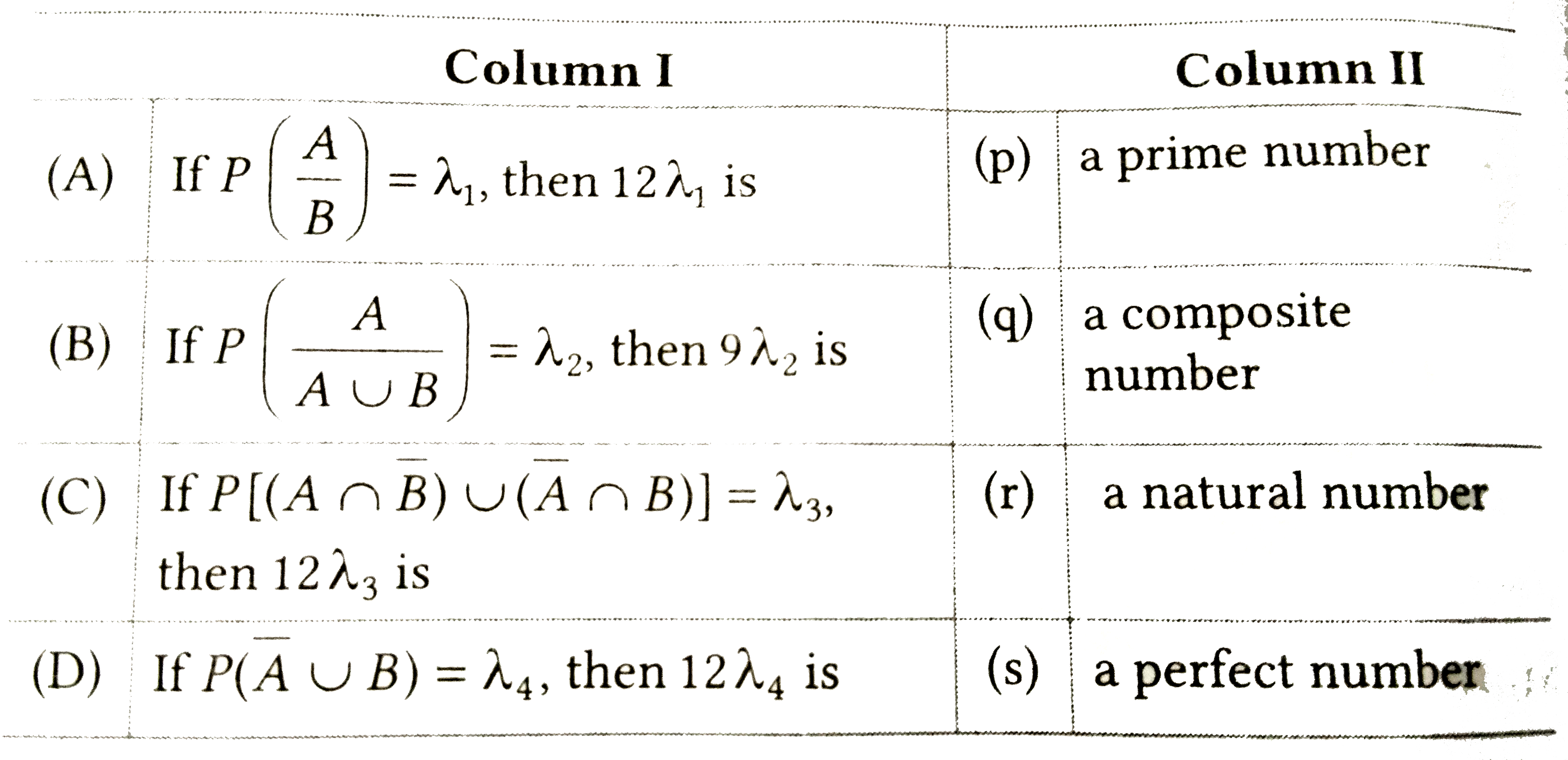If A and B are two events such that P(A∪B)=56,P(A)=13andP(B)=34, then A and B are
mutually exclusive
dependent
independent
None of these
The correct Answer is:(c)
To solve the problem, we need to determine the relationship between the two events A and B based on the given probabilities.
Given:
- P(A∪B)=56
- P(A)=13
- P(B)=34
Step 1: Use the formula for the probability of the union of two events.
The formula for the probability of the union of two events is given by:
P(A∪B)=P(A)+P(B)−P(A∩B)
Step 2: Substitute the known values into the formula.
Substituting the values we have:
56=13+34−P(A∩B)
Step 3: Convert fractions to a common denominator.
The common denominator for 13 and 34 is 12. We convert:
13=412,34=912
Thus, we rewrite the equation:
56=412+912−P(A∩B)
Step 4: Simplify the equation.
Now, simplify the left side:
56=1312−P(A∩B)
Next, convert 56 to a fraction with a denominator of 12:
56=1012
So we have:
1012=1312−P(A∩B)
Step 5: Solve for P(A∩B).
Rearranging gives us:
P(A∩B)=1312−1012=312=14
Step 6: Determine if A and B are mutually exclusive, independent, or dependent.
- Mutually Exclusive: If P(A∩B)=0, then A and B are mutually exclusive. Here, P(A∩B)=14≠0, so they are not mutually exclusive.
- Independent: If P(A∩B)=P(A)⋅P(B), then A and B are independent.
- Calculate P(A)⋅P(B):
P(A)⋅P(B)=13⋅34=14
Since P(A∩B)=14, A and B are independent.
Conclusion:
Thus, A and B are independent events.
- P(A∪B)=56
- P(A)=13
- P(B)=34
The formula for the probability of the union of two events is given by:
P(A∪B)=P(A)+P(B)−P(A∩B)
Substituting the values we have:
56=13+34−P(A∩B)
The common denominator for 13 and 34 is 12. We convert:
13=412,34=912
Thus, we rewrite the equation:
56=412+912−P(A∩B)
Now, simplify the left side:
56=1312−P(A∩B)
Next, convert 56 to a fraction with a denominator of 12:
56=1012
So we have:
1012=1312−P(A∩B)
Rearranging gives us:
P(A∩B)=1312−1012=312=14
- Mutually Exclusive: If P(A∩B)=0, then A and B are mutually exclusive. Here, P(A∩B)=14≠0, so they are not mutually exclusive.
- Independent: If P(A∩B)=P(A)⋅P(B), then A and B are independent.
- Calculate P(A)⋅P(B):
P(A)⋅P(B)=13⋅34=14
Since P(A∩B)=14, A and B are independent.
Thus, A and B are independent events.
Topper's Solved these Questions
- PROBABILITYBOOK - ARIHANT MATHS ENGLISHCHAPTER - PROBABILITYEXERCISE - Exercise For Session 3
10 Videos
- PROBABILITYBOOK - ARIHANT MATHS ENGLISHCHAPTER - PROBABILITYEXERCISE - Exercise For Session 4
15 Videos
- PROBABILITYBOOK - ARIHANT MATHS ENGLISHCHAPTER - PROBABILITYEXERCISE - Exercise For Session 1
20 Videos
- PERMUTATIONS AND COMBINATIONS BOOK - ARIHANT MATHS ENGLISHCHAPTER - PERMUTATIONS AND COMBINATIONS EXERCISE - Exercise (Questions Asked In Previous 13 Years Exam)
28 Videos
- PRODUCT OF VECTORSBOOK - ARIHANT MATHS ENGLISHCHAPTER - PRODUCT OF VECTORSEXERCISE - Exercise (Questions Asked In Previous 13 Years Exam)
51 Videos
Similar Questions
Knowledge Check
If A and B be two events such that P(A)=12P(B)=13andP(AB)=14 thenP(A∩B) equals
A112B34C14D316
If A and B are events such that P(A'∪B')=34,P(A'∩B')=14 and P(A)=13, then find the value of P(A'∩B)
View SolutionA and B are two events such that P(A∪B)=34,P(A)=13,P(¯¯¯A∩B)=
View SolutionIf A and B are two events such that P(A)=14,P(B)=12 and P(A∩B)=18, find P (not A and not B).
View SolutionIf A and B are two independent events, such that P(A)=13andP(B)=14.

View SolutionIf A and B are two events such that P(B)=35,P(A/B)=12 and P(A∪B)=45, then P(A) equals to
View SolutionIf A and B are two events such that P(A)=13,P(B)=15 and P(A∪B)=1130, Find P(AB) and P(BA).
View SolutionLet A and B be two events such that
P(A)=12,P(B)=pandP(A∪B)=35
find 'p' if A and b are independent events.
View Solution
